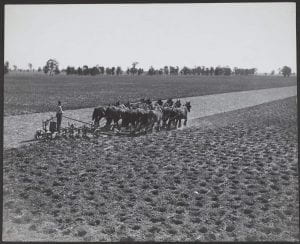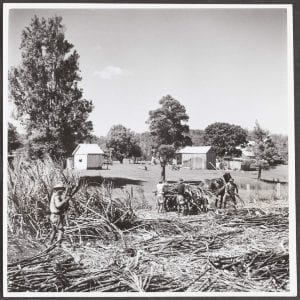A Glimpse into Farming in New South Wales
Alhassan Shaibu is a PhD candidate in the University of Melbourne’s Asia Institute. His thesis focuses on the interpretation and application of Islamic legal texts: and the contributions of the Hanbali jurist Ibn Qudāmah (d.620/1223).
The Commercial Travellers Association (CTA) aimed to support the wellbeing of salesmen travelling across Australia, but alongside their business trips, the organisation kept accounts of rural and regional developments along their trading routes. This article discusses the state of agriculture in New South Wales (NSW) during the 1930s based on the collection of photograph commissioned by the Commercial Travellers Association of Australia that operated for about 134 years (1880-2014) (University of Melbourne Archives).

Using the search criteria “farm” and “plantation” to identify records, reveals a small group of pictures which help to uncover the role played by NSW farmers during an intensive period of adaptation – trial and error – with modern methods of farming in the history of Australian agriculture (Pratley & Rowell 2003).
The first picture shows a rural scene depicting a horse farm in 1929 (Figure 1). On a fading horizon of this vast land, the farm houses a string of mares and younger foals. In a far-off distance to the left, one can see some structures which appear to be houses, the size of which will preclude them from being stables. Judging from those structures, it is unclear whether the caretakers lived on the land The land appears bare, with only a few trees, one without any leaves. On the horizon, just where the land meets the sky, one can hypothesize there are more house-like structures, who know? What we see however is a vast cleared land, perhaps overly grazed with thin horses clinging to the fence near a dam.

Figure 2 continues this pictorial narrative of a recently cleared landscape supporting farm animals, this time showing cattle in a fenced area, and the inscription suggests that the cows were ready to be milked. It is a grainy picture, but one can make out the cattle and some plant growth close to the distant farm buildings.

In the following picture, the collection turns more to the role of animals in horticulture, with horses being used to plough the cleared land of the farm (figure 3). About 12 horses draw the steel discs of the plough with one person manning the carriage behind. Here too, one can see some vegetation in the far-off distance, juxtaposed and framing the horizon of the farmland.
Turning now towards the more intensive activity of agriculture, Figures 4 and 5 show a harvesting period for banana and sugar cane, respectively. In the banana plantation, a young girl can be seen leaning against a prop that supports a banana plant. She appears casual, uncaring, a leg crossed over the other. The trees are heavy laden with fruits, the bunches larger and heavier than the young girl. A very fruitful year maybe, or perhaps good farm management practices. The young girl in the photograph suggests that the farm owners probably employed their family’s assistance on the farm or perhaps workers lived on the farm with their families as can be inferred from the other pictures. The little girl also shows the size of the bunch of banana comparatively; with her small size exaggerating the abundance of the crop.

The next image contrasts in showing the hard work of cutting the crop (Figure 5) and depicts the use of horses and a carriage in transporting the harvest. In northern NSW, bananas and cane required more intensive human labour because of their dense growth patterns.
The CTA did not curate a comprehensive account of agriculture in NSW. Yet the few photographs they kept in their collections keep traces of the robust activities of these farmers during the 1930s.

Refence:
- Pratley, J., & Rowell, L. (2003). Evolution of Australian Agriculture. In J. Pratley (Ed.), Principles of field crop production (4th ed. / 1 ed., pp. 1-25). Oxford University Press. Retrieved September 10, 2020, https://www.csu.edu.au/__data/assets/pdf_file/0005/2805521/Chapter1_PratleyRowell.pdf
- The University of Melbourne Archives (2014). Administrative records and Publications. Retrieved September 10, 2020, http://gallery.its.unimelb.edu.au/imu/imu.php?request=multimedia&irn=1926
- The University of Melbourne Archives https://archives.unimelb.edu.au or http://gallery.its.unimelb.edu.au/umblumaic/imu.php?request=search&context
- West, C. A. M. (1945). Fifty years of development: The United commercial Travellers’ Association of Australia limited. Retrieved September 10, 2020, http://handle.slv.vic.gov.au/10381/182005
Leave a Reply